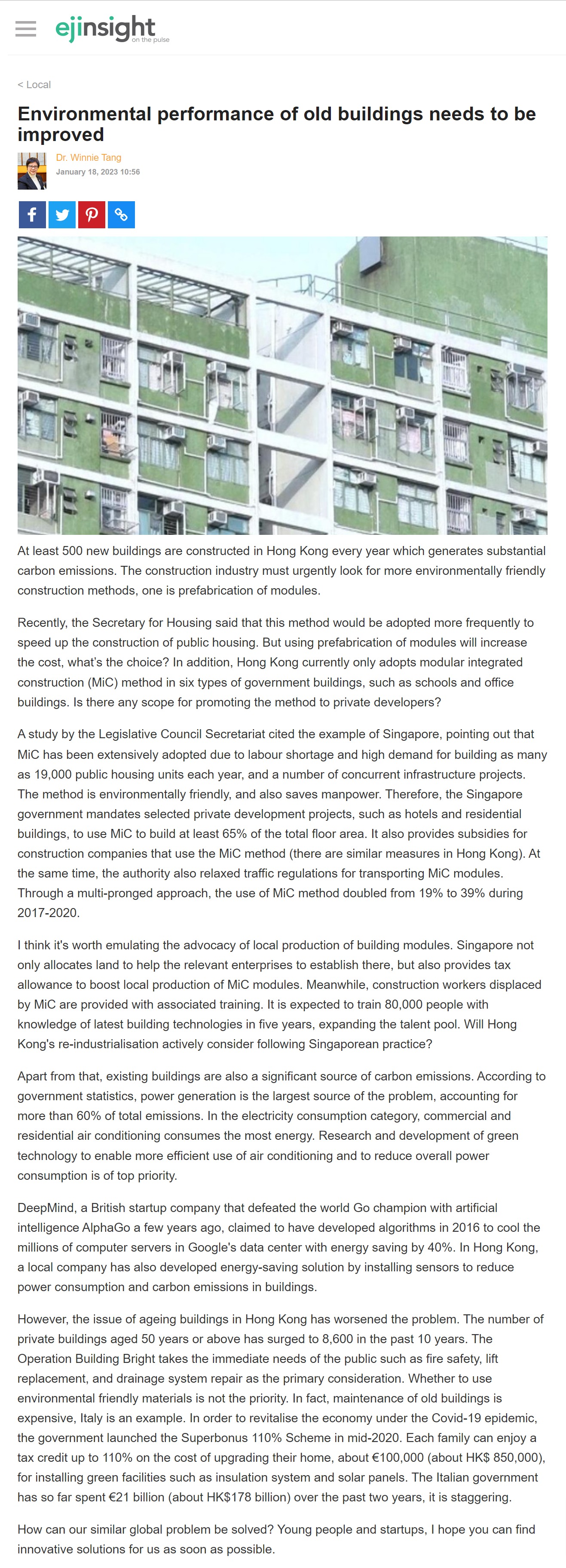網上版請按此

Environmental performance of old buildings needs to be improved
At least 500 new buildings are constructed in Hong Kong every year which generates substantial carbon emissions. The construction industry must urgently look for more environmentally friendly construction methods, one is prefabrication of modules.
Recently, the Secretary for Housing said that this method would be adopted more frequently to speed up the construction of public housing. But using prefabrication of modules will increase the cost, what's the choice? In addition, Hong Kong currently only adopts modular integrated construction (MiC) method in six types of government buildings, such as schools and office buildings. Is there any scope for promoting the method to private developers?
A study by the Legislative Council Secretariat cited the example of Singapore, pointing out that MiC has been extensively adopted due to labour shortage and high demand for building as many as 19,000 public housing units each year, and a number of concurrent infrastructure projects. The method is environmentally friendly, and also saves manpower. Therefore, the Singapore government mandates selected private development projects, such as hotels and residential buildings, to use MiC to build at least 65% of the total floor area. It also provides subsidies for construction companies that use the MiC method (there are similar measures in Hong Kong). At the same time, the authority also relaxed traffic regulations for transporting MiC modules. Through a multi-pronged approach, the use of MiC method doubled from 19% to 39% during 2017-2020.
I think it's worth emulating the advocacy of local production of building modules. Singapore not only allocates land to help the relevant enterprises to establish there, but also provides tax allowance to boost local production of MiC modules. Meanwhile, construction workers displaced by MiC are provided with associated training. It is expected to train 80,000 people with knowledge of latest building technologies in five years, expanding the talent pool. Will Hong Kong's re-industrialisation actively consider following Singaporean practice?
Apart from that, existing buildings are also a significant source of carbon emissions. According to government statistics, power generation is the largest source of the problem, accounting for more than 60% of total emissions. In the electricity consumption category, commercial and residential air conditioning consumes the most energy. Research and development of green technology to enable more efficient use of air conditioning and to reduce overall power consumption is of top priority.
DeepMind, a British startup company that defeated the world Go champion with artificial intelligence AlphaGo a few years ago, claimed to have developed algorithms in 2016 to cool the millions of computer servers in Google's data center with energy saving by 40%. In Hong Kong, a local company has also developed energy-saving solution by installing sensors to reduce power consumption and carbon emissions in buildings.
However, the issue of ageing buildings in Hong Kong has worsened the problem. The number of private buildings aged 50 years or above has surged to 8,600 in the past 10 years. The Operation Building Bright takes the immediate needs of the public such as fire safety, lift replacement, and drainage system repair as the primary consideration. Whether to use environmental friendly materials is not the priority. In fact, maintenance of old buildings is expensive, Italy is an example. In order to revitalise the economy under the Covid-19 epidemic, the government launched the Superbonus 110% Scheme in mid-2020. Each family can enjoy a tax credit up to 110% on the cost of upgrading their home, about €100,000 (about HK$ 850,000), for installing green facilities such as insulation system and solar panels. The Italian government has so far spent €21 billion (about HK$178 billion) over the past two years, it is staggering.
How can our similar global problem be solved? Young people and startups, I hope you can find innovative solutions for us as soon as possible.
Dr. Winnie Tang
Adjunct Professor, Department of Computer Science, Faculty of Engineering; Department of Geography, Faculty of Social Sciences; and Faculty of Architecture, The University of Hong Kong